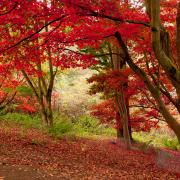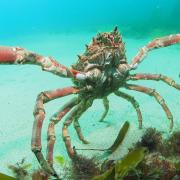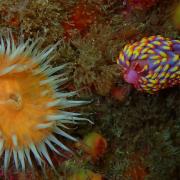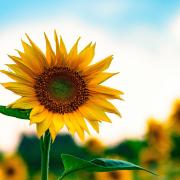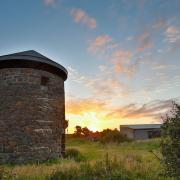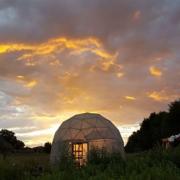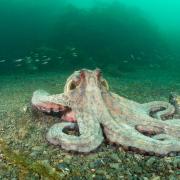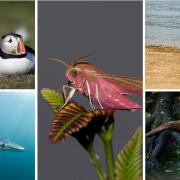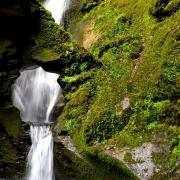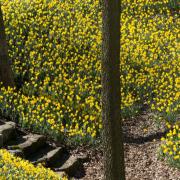Churchyards are a sanctuary for both people and wildlife, writes Tamara Weeks, Conservation Assistant with the Cornwall Wildlife Trust
Our countryside has changed enormously over recent decades due to development and agricultural changes. Some areas remain sympathetically managed but many natural habitats have been lost and fragmented, which has led to a widespread loss of wildlife. Churchyards, however, have been part of our lives and landscapes for centuries and have generally remained unchanged over this time, escaping ploughing, artificial fertilisers and pesticides. They may hold relics of declining habitats like heathland or unimproved grassland and support rare or unusual species which were once common in the wider countryside.
Churchyards often contain many different habitats within a small area, providing a place for all sorts of wildlife to thrive – wildflowers, ancient trees, insects, birds, reptiles and mammals, as well as lichens, mosses and fungi.
Churchyards can be managed to encourage wildlife to live in them, without detracting from their primary role for the congregation and visitors. The Living Churchyards Project is a joint initiative between Cornwall Wildlife Trust and the Diocese of Truro. The project provides support and advice to those interested in managing their local churchyard for wildlife.
Most churchyards will be able to provide a sanctuary for wildlife and just a few simple changes in their management can be all that is needed. For example, altering the mowing regime to encourage wildflowers, maintaining border strips of flowering grasses, avoiding chemicals, taking care to conserve lichens, installing bird and bat boxes, encouraging plants with berries and nectar, native trees and shrubs for cover and shelter, or creating compost heaps and log piles. Even leaving ivy on trees helps to provide food and shelter for insects and birds.
Churchyard wildlife
Lichens thrive particularly well in churchyards thanks to the different types of stonework found in them, from gravestones and monuments, to the church walls. These fascinating organisms, made up of algae and fungi, may also live on mature trees and benches. Lichens are very sensitive to pollution, but Cornwall’s clean maritime air encourages a variety of species to grow. Several churchyards in Cornwall support over 100 different species, and the remote church of St Gennys, near Crackington Haven, has the most diverse lichen flora recorded in the county, with a total of 150 species.
Colourful displays of wildflowers are common. At St Clement Church near Truro, an area managed as a spring meadow will be awash with bluebells and primroses, while another shaded section of the churchyard forms the woodland corner, with attractive woodland flowers, including the delicate wood anemone. Removing grass cuttings to reduce grassland fertility has also seen many more flowers reappear naturally across the site, such as early spotted orchid, cowslip, ragged robin and purple loosestrife. Baldhu Church, outside Threemilestone, is where heathland flora persists. Heath-grass, heath bedstraw, purple moor-grass and lousewort have all been recorded here. Such unimproved habitats support a wide variety of insect life, which in turn benefits other wildlife that feed on them including birds and bats.
The churchyard at St Uny, Lelant, is managed for its range of flowers, and areas of grassland are left long and uncut until October, allowing plants to flower and set seed. Grasses include red fescue, creeping bent and false oat-grass, and wildflowers such as yarrow, meadow vetchling, common restharrow, knapweed and field scabious are abundant. The latter produces lilac, rounded flowerheads that are an important nectar source for butterflies like the small skipper, meadow brown and small tortoiseshell and are essential for the churchyard’s colony of the rare solitary mining bee, Andrena hattorfiana. The female bee lays her eggs on scabious flowers and the grubs then feed on the pollen.
Ancient trees frequently occur in churchyards and are important for insect communities and birdlife. Bats make use of splits and cracks in mature trees, and in some cases may roost in undisturbed parts of church buildings. Minster Church, near Boscastle, supports one of the largest greater horseshoe bat maternity roosts in the UK, making it of national conservation importance.
A community resource
Creating a haven for wildlife brings benefits for people too. Local communities can get involved by attending open days and events, helping with surveys and practical work, keeping a photographic record or even providing refreshments for the task force.Churchyards can also be an excellent educational resource and children have no qualms about searching amongst our living churchyards for creatures such as frogs and slow worms or looking for signs of other wildlife that use these areas after dark. For adults, workshops organised through the Living Churchyards Project have included demonstrations of practical management, identification of lichens and wildflowers, surveying for small mammals and the wildlife value of hedges.I encourage you to take a fresh look at your local churchyard and see what wildlife abounds amongst the gravestones. You might even discover a rare wildflower, see all sorts of lichens or catch a glimpse of a beautiful butterfly!
For more information about the Living Churchhyards Project contact Robert Moor on 01872 272929 or visit www.cornwallwildlifetrust.org.uk/churchyards
Where to spot wildlife in local churchyards
St Gennys Church, near Crackington Haven, has over 150 species of lichen St Clement Church, near Truro, is great for wild flowers such as early spotted orchid, bluebells, primroses and wood anemoneBaldhu Church, near Threemilestone, Truro, has heathland flora such as heath-grass, heath bedstraw, purple moor-grass and lousewort.St Uny Church, Lelant, has grasslands where you’ll see red fescue, false oat-grass, yarrow, meadow vetchling, field scabious and butterflies such as small skipper, meadow brown and small tortoiseshell. There’s also a colony of the rare solitary mining bee, Andrena hattorfiana.Minster Church, near Boscastle, supports one of the largest greater horseshoe bat maternity roosts in the UK
Wildlife records
Whether it’s mosses, lichen, fungi, vascular plants, birds, mammals or invertebrates, the Environmental Records Centre for Cornwall and the Isles of Scilly (ERCCIS), hosted by Cornwall Wildlife Trust, is keen to hear about any wildlife you’ve spotted in your local churchyard or wider countryside. Just record what you saw, where you saw it, when you saw it and who you are. For more information and to send ERCCIS your wildlife records visit www.erccis.co.uk/wildlife_recording or contact the Wildlife Information Service on 01872 240777, ext 250







